Hyundai Elantra: Charging System / Battery Repair procedures
| 1. |
Turn the ignition switch OFF. |
| 2. |
Disconnect the battery (-) terminal (A). 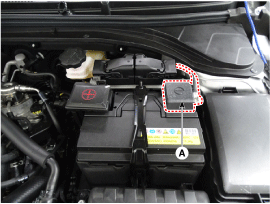
|
| 3. |
Remove the battery (+) terminal (B). 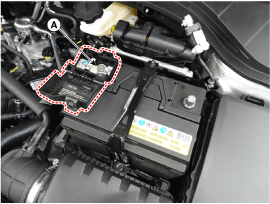
|
| 4. |
Remove the battery mouting bracket (A). |
| 5. |
Remove the battery insulation pad after removing the battery (B). 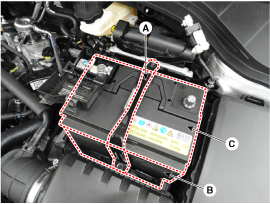
|
| 1. |
Remove the battery.
(Refer to "Removal") |
| 2. |
Remove the air cleaner assembly.
(Refer to Engine Mechanical System - "Air Cleaner") |
| 3. |
Remove the ECM.
(Refer to Engine Control / Fuel System - "Engine Control Module (ECM)") |
| 4. |
Remove the battery tray (A) after loosening the bolts. 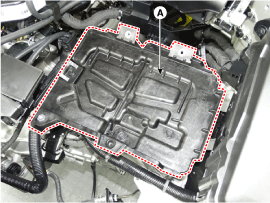
|
| 1. |
Install in the reverse order of removal.
Battery (-)terminal installation:
7.8 ~ 9.8 N.m (0.8 ~ 1.0 kgf.m, 5.8 ~ 7.2 lb-ft)
Battery (+)terminal installation:
7.8 ~ 9.8 N.m (0.8 ~ 1.0 kgf.m, 5.8 ~ 7.2 lb-ft)
Battery mounting bracket and the insulation pad installation:
19.6 ~ 29.4 N.m (2.0 ~ 3.0 kgf.m, 14.5 ~ 30.4 Ib-ft)
|
| • |
When installing the battery, fix the mounting bracket on the tray correctly. |
|
|
[AGM battery charging]
AGM battery should be charged with constant voltage or
constant current-constant voltage in order to minimize performance
degradation due to the charging.
If charging the battery with constant current, overcharging
may occur. It can cause damage to the internal battery and will give an
adverse effect on battery life.
| • |
Do not charge with more than 14.8V or quick charge mode. |
|
[Constant voltage charge conditions]
Charging voltage / time :
14.7V [68°F ~ 86°F (20°C ~ 30°C)] / approximately 24 hours
The minimum charge voltage :
14.4V [68°F ~ 86°F (20°C ~ 30°C)]
The maximum charging voltage :
14.8V [68°F ~ 86°F (20°C ~ 30°C)]
|
| • |
Battery temperature should be maintained at about 68°F ~ 86°F (20°C ~ 30°C) during charging of the battery. |
|
| • |
If the battery is charged directly at the battery terminals
on vehicles with battery sensor, misinterpretations of battery condition
and under certain circumstances also unwanted Check Control messages or
fault memory entire can occur.
After recharging finished, let the battery stand for over 10 hours with normal temperature for battery stabilization. |
|
| 1. |
Make sure the ignition switch and all accessories are in the OFF position. |
| 2. |
Disconnect the battery negative cables (A). |
| 3. |
Remove the battery from the vehicle.
(Refer to Charging System - "Battery")
| • |
Care should be taken in the event the battery case is cracked or leaking, to protect your skin from the electrolyte. |
| • |
Heavy rubber gloves (not the household type) should be worn when removing the battery. 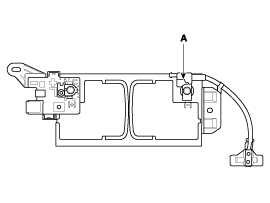
|
|
|
| 4. |
Inspect the battery tray for damage caused by the loss of
electrolyte. If acid damage is present, it will be necessary to clean
the area with a solution of clean warm water and baking soda. Scrub the
area with a stiff brush and wipe off with a cloth moistened with baking
soda and water. |
| 5. |
Clean the top of the battery with the same solution as described above. |
| 6. |
Inspect the battery case and cover for cracks. If cracks are present, the battery must be replaced. |
| 7. |
Clean the battery posts with a suitable battery post tool. |
| 8. |
Clean the inside surface of the terminal clamps with a
suitable battery cleaning tool. Replace damaged or frayed cables and
broken terminal clamps. |
| 9. |
Install the battery in the vehicle. |
| 10. |
Connect the cable terminals to the battery post, making sure tops of the terminals are flush with the tops of the posts. |
| 11. |
Tighten the terminal nuts securely. |
| 12. |
Coat all connections with light mineral grease after tightening.
| • |
When batteries are being charged, an explosive gas forms
beneath the cover of each cell. Do not smoke near batteries being
charged or which have recently been charged. Do not break live circuit
at the terminals of batteries being charged. |
| • |
A spark will occur when the circuit is broken. Keep open flames away from battery. 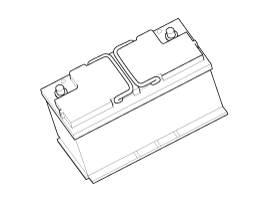
|
|
|
| Vehicle parasitic current inspection |
| 1. |
Turn the all electric devices OFF, and then turn the ignition switch OFF. |
| 2. |
Close all doors except the engine hood, and then lock all doors.
| (1) |
Disconnect the hood switch connector. |
| (3) |
Close the doors or remove the door switches. |
|
| 3. |
Wait a few minutes until the vehicle’s electrical systems go to sleep mode.
| • |
For an accurate measurement of a vehicle parasitic current,
all electriacl systems should go to sleep mode. (It takes at least one
hour or at most one day.) However, an approximate vehicle parasitic
current can be measured after 10~20 minutes. |
|
|
| 4. |
Connect an ammeter in series between the battery (-) terminal
and the ground cable, and then disconnect the clamp from the battery
(-) terminal slowly.
| • |
Be careful that the lead wires of an ammeter do not come off
from the battery (-) terminal and the ground cable to prevent the
battery from being reset. In case the battery is reset, connect the
battery cable again, and then start the engine or turn the ignition
switch ON for more than 10 sec. Repeat the procedure from No. 1.
To prevent the battery from being reset during the inspection, |
| 1) |
Connect a jump cable between the battery (-) terminal and the ground cable. |
| 2) |
Disconnect the ground cable from the battery (-) terminal. |
| 3) |
Connect an ammeter between the battery (-) terminal and the ground cable. |
| 4) |
After disconnecting the jump cable, read the current value of the ammeter. |
|
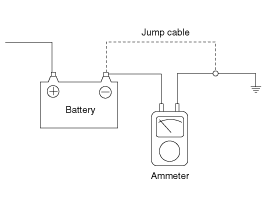
|
| 5. |
Read the current value of the ammeter.
| A. |
If the parasitic current is over the limit value, search for
abnormal circuit by removing a fuse one by one and checking the
parasitic current. |
| B. |
Reconnect the suspected parasitic current draw circuit fuse
only and search for suspected unit by removing a compoconnected with the
circuit one by one until the parasitic draw drops below limit value. |
Limit value (after 10 ~ 20 min.) : Below 50 mA
|
|
Components
1. Battery insulation pad2. AMG Battery3. Battery tray4. Battery mounting bracket5. Battery sensor
...
Other information:
Hyundai Elantra AD (2016-2020) Owners Manual: Driving Your Vehicle
WARNING
Carbon monoxide (CO) gas is toxic. Breathing CO can cause unconsciousness
and death.
Engine exhaust contains carbon monoxide which cannot be seen or smelled.
Do not inhale engine exhaust.
If at any time you smell engine exhaust inside the vehicle, open the windows
immediately. Exposu ...
Hyundai Elantra AD (2016-2020) Owners Manual: Driving in Flooded Areas, Highway Driving
Driving in Flooded Areas
Avoid driving through flooded areas unless you are sure the water is no higher
than the bottom of the wheel hub. Drive through any water slowly. Allow adequate
stopping distance because brake performance may be reduced.
After driving through water, dry the brakes by ge ...
 Battery Components and Components Location
Battery Components and Components Location Battery Troubleshooting
Battery Troubleshooting









